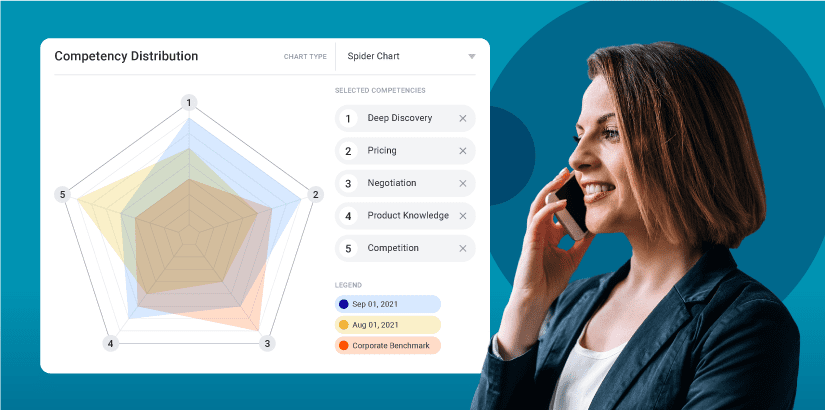Data-Driven Sales Coaching: How to Use Data to Drive Coaching Conversations
![]() Helen Waite
on
July 18, 2024
Helen Waite
on
July 18, 2024
As a revenue leader, you’re likely well aware of the potential impact of great sales coaching on team performance. In fact, the power of sales coaching is proven. A recent analysis found that top sellers receive significantly more sales coaching than average.
But generic, one-size-fits-all sales coaching doesn’t work. Furthermore, while deal coaching may improve the outcome of a single deal, it won’t have much of an impact on a rep’s long-term behaviors and sales performance.
Instead, sales managers must deliver tailored skill coaching that addresses the strengths and weaknesses of each of their sales reps. But first, they must have the right data to understand what those strengths and weaknesses are.
In this post, we’ll explore why your current approach to sales coaching isn’t working – and why data-driven sales coaching is the answer.
Why coaching conversations must change
Having conversations about performance can be hard, especially if a rep isn’t doing well. It can be especially difficult to call out areas for improvement when you don’t have the specifics to back it up. Relying on data makes these conversations easier.
For sales managers, being able to track and analyze seller performance all in one place using revenue enablement software provides concrete insight into every time you say “you’re doing a great job” or “there’s room for improvement.” Your feedback is rooted in actual performance metrics, rather than running the risk of being considered your opinion rather than fact.
Data also helps us to identify the exact ways each seller can improve. Perhaps one rep is weaker in their competitor knowledge while another may need more support when it comes to operating sales technology. By digging into the data, an effective sales coach can identify opportunities for improvement and, in turn, maximize each rep’s performance.

What a data-driven approach looks like
In order to adopt a data-driven coaching approach, you should have a clear understanding of the key metrics you should be looking at. These will help you gauge the overall success of your sales force, but really allow you to dig into individual performance to fuel more impactful coaching conversations.
Below we’ve highlighted some key criteria you’ll want to evaluate—and how you can gather the data.
Product knowledge: Assess and certify sellers on their product knowledge with quizzes using different formats. You can create a proficiency threshold score for reps to show they’re knowledgeable experts on your product, which you can test through multiple-choice quizzes, checklists, and written tests.
Reps can also be assigned role-plays to see if they can demo the product, describe what it does and accurately express the value of the product. If you’re using sales readiness technology, all of this can be easily reviewed and scored through artificial intelligence (AI).
Selling behavior: Evaluate how articulate and enthusiastic a rep is on a call, voicemail or presentation as well as the tone. You can also keep track of how many filler words are used. This will gauge their overall confidence in selling your solution.
Selling skills: By tracking sellers’ progress in real-time, sales coaches can get data insights on each rep’s ability to demo, use a sales methodology (e.g. MEDDPIC) on a call, challenge competition, handle objection questions, and evaluate whether or not the correct terms are used to describe the product.
Message consistency: AI-powered keyword analysis is a great way for sales coaches to get better insight into individual competencies and needs based on live interactions during the selling process. When you analyze sales calls (and leave the hard work to AI), you can uncover key problems in deals that didn’t close and start training on common questions you’re finding reps are being asked in the field.
Technology skills: How well do your reps use sales tools? Assess sellers on their knowledge (and correct use) of sales stack tools like Outreach, Ring, Zoom, and Salesforce to see how effectively they’re being put into action.
Using a revenue enablement platform, reps can actually record themselves using the tools, which can then be evaluated and scored. This will give sales coaches visibility into any challenges with tech on the team.
Your new approach to coaching starts now
On top of using data to coach reps, this data-driven approach also empowers you to establish a “profile of excellence” on your sales team. This helps sales managers to identify their best performers and replicate their skillset amongst other reps through training and coaching.
While it certainly makes it easier to track and report on these metrics with revenue enablement technology in place, it’s not impossible to do without. However you gather the data, it’s important to start bringing it into coaching conversations in order to pinpoint areas for improvement, provide more specific feedback, and ultimately empower you as a sales coach to help your team succeed.
Start delivering effective, data-driven coaching at scale with Mindtickle
The impact of sales coaching can’t be denied. However, in order to be effective, sales coaching must be tailored to the needs of each sales rep.
With Mindtickle’s integrated revenue enablement platform, you can start delivering data-driven coaching that’ll improve reps’ behaviors and grow sales performance.
With Mindtickle, you can easily understand deal risk and buyer engagement. Then, you can use those insights to provide coaching to improve the outcome of deals.
Mindtickle also empowers you to go beyond deal coaching to deliver skill coaching that improves long-term results. With Mindtickle, you can understand how reps are performing in the field and what their strengths and weaknesses are. Then, you can use this intel to deliver coaching to improve lagging skills and long-term behaviors and performance.
Of course, delivering coaching and hoping for the best isn’t an effective approach. With Mindtickle, revenue leaders can actually understand the impact of their coaching efforts. Then, they can optimize their approach for even better results.
This post was originally published in June 2021 and updated in July 2024.
Data Driven Sales Coaching with Mindtickle
Get a demo today to see how Mindtickle can help to enhance your coaching programs.
Get a Demo


